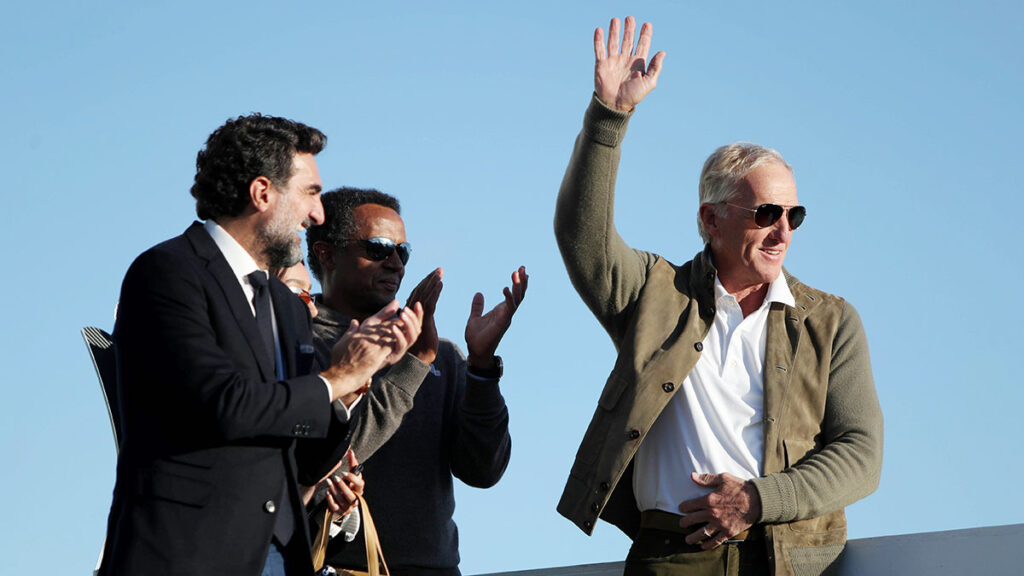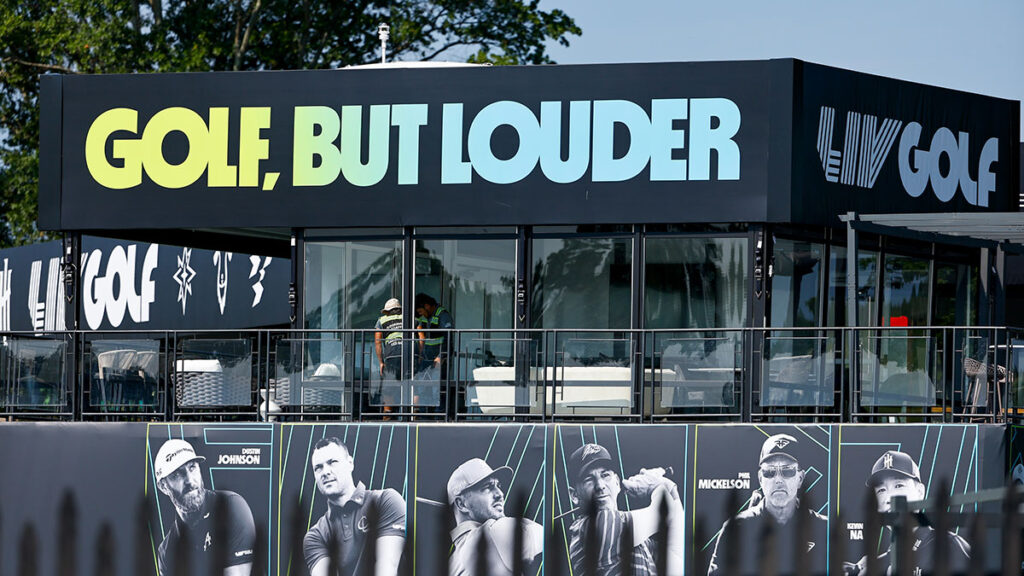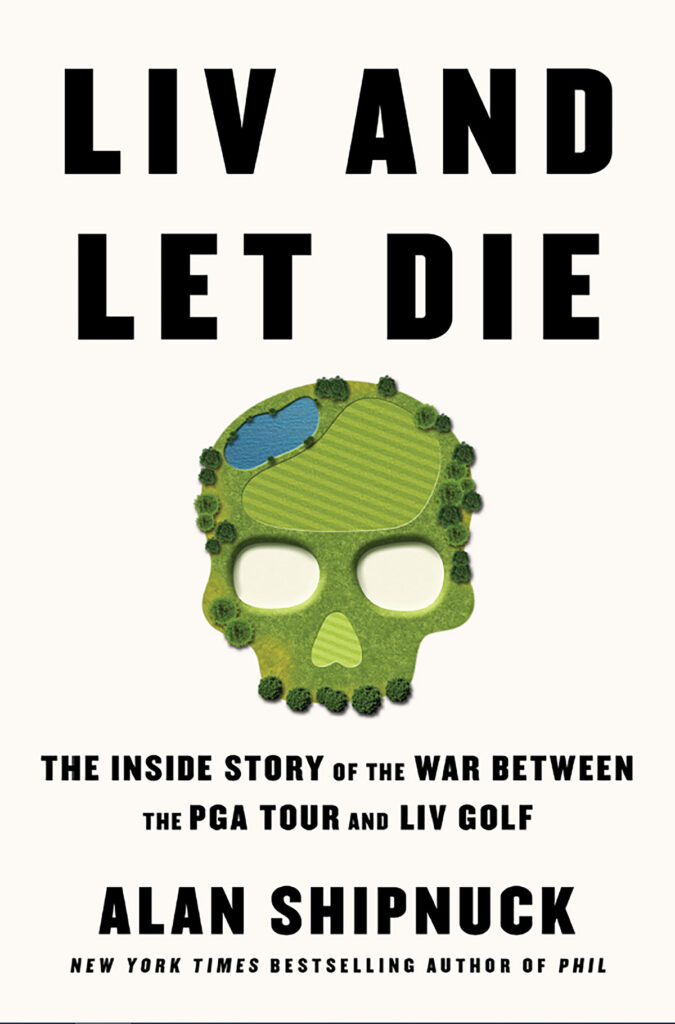Why LIV Golf’s inaugural Australian tournament, held in Adelaide this past April, provided the breakaway circuit’s moment of enlightenment.
Two weeks after the Masters, LIV blew into Adelaide for its first tournament in Australia. Vibe check?
“Sick,” said Jed Morgan.
“Epic,” said Cam Smith.
“Unbelievable,” said Marc Leishman.
LIV Golf Adelaide accommodated 25,000 fans a day, and the anticipation was such that tickets sold out months in advance. The all-Aussie Ripper team of Smith, Morgan, Leishman, and Matt Jones was the focus of the week. Of his opening tee shot, Smith said, “Yeah, that first fairway looked pretty narrow this morning – it seemed like everyone was on the edge of the fairway.”
The Grange Golf Club featured a Phoenix Open-style party hole, encasing the par-3 12th hole with 5,000 fans. The beer – including Leishman Lager, a “dry, crisp malt with notes of lime zest”, according to one web review – flowed like a river, leading to the nickname “the Watering Hole”. Players strutted to the tee with booming walk-up music. Dustin Johnson chose AC/DC’s “Back in Black”, and Phil Mickelson went with Eminem’s “Lose Yourself”, a couple of classic bangers. Brooks Koepka’s selecting Meek Mill’s “Dreams and Nightmares” added some context as to why he had bought his brother, Chase, a Lamborghini after their team win in Jeddah, as the song includes a memorable paean to a “Lambo”. Chase produced a highlight that went around the world when he aced the Watering Hole during the final round, touching off a wild celebration with the sodden fans showering the players, and one another, with various beverages. “I smelled like beer for the rest of the round,” he said.
Talor Gooch wowed the crowd by opening with rounds of 62-62 to forge a stunning 10-stroke lead. “This is what gets you up in the morning, to play in front of crowds like this with energy like this,” he said. The tightly bunched team leaderboard provided needed final-round drama, as the 4Aces eked out a one-stroke win over Gooch’s RangeGoats. Gooch laboured to a closing 73, winning the individual title by three strokes. His teammates – Bubba Watson, Harold Varner III and Thomas Pieters – mobbed him on the final green, but the champ apologised to his fellow Goats for not playing better and helping the squad get a win. That buy-in on the team component, along with the raucous crowds, led Gooch to say, “I think they’re just now starting to get a feel for what LIV is.”
Indeed, the success of LIV Golf Adelaide left LIV commissioner Greg Norman in a triumphant mood. He had been treated by his fellow Aussies as a conquering hero upon returning to the town where he had won his first professional tournament, in 1976. Given Norman’s penchant for gaffes, he had not been part of a press conference since LIV had launched, but he finally sat for one in Adelaide, alongside the premier of South Australia, Peter Malinauskas. “We are not coming in here just flashing and burning and disappearing,” Nor- man said. “It’s a partnership with the state. It’s a partnership with the country, but it’s a partnership for the game of golf. Forgetting all the white noise that everybody writes about and talks about, this is all about what’s good for the game of golf and what’s good for the local region. From my perspective, having the ability to be able to move the needle in that direction and to be involved with the South Australian Government or any other country around the world is very, very powerful and poignant. Trust me, this morning my phone is ringing off the hook, but it’s not just Australia, it’s the rest of the world, too.” (We don’t trust you, Greg, but OK.)

Australia is a proud golfing nation that has largely been abandoned by the highest levels of the professional game. The reception at the Adelaide event drove home that LIV can be most meaningful playing around the world in markets that rarely see big-name players. “You could see how this LIV thing is just really exploding,” said Pat Perez. “I think when we go more worldwide, you’re going to see this kind of stuff. I think that’s what we should stay with, myself.”
Of course, the Australian national character embraces the rebellious and the anti-establishment, making for a perfect match with the image that LIV, and Norman, have cultivated. (Aussie golf fans also blame the PGA Tour’s increasingly year-round schedule for preventing many players from supporting historic tournaments Down Under.) Sky Sports commentator Jamie Weir had been a biting critic of LIV, putting him on the front lines of various social media battles. Of the LIV supporters, he tweeted, “They come in all shapes and sizes, but there definitely seems to be two main groups who are the staunchest pro-LIV, anti-established tours and OWGR, the angriest, most vocal and easily irked on Twitter: the MAGA/Trump contingent and… Australians.”
At his press conference, Malinauskas brushed aside questions about being an enabler of sportswashing with a clear-eyed perspective. “We sell extraordinary amounts of barley, beef, lamb, amongst other things to Saudi Arabia,” he said. “It’s a $3 billion trading partnership between Australia and Saudi Arabia. There are $4 billion worth of active investments in Australia alone. So we choose as a country to actively trade with Saudi Arabia, the largest economy within the Middle East, and we do that knowingly, without at any step of the way compromising what we collectively believe in as a country.”
After a slow start, Smith rallied to tie for third, delighting the home crowd. He admitted he chose LIV in part because of the promise to be able to play in front of his loved ones and countrymen; owing to covid travel restrictions, he didn’t see his family for three years. At the end of a satisfying week in Adelaide, the Champion Golfer of the Year said, “I think it’s a massive boost. I think it gives the tour a lot of confidence and momentum. I think it’s going to be the benchmark for LIV Golf going forward.”
• • •

Perhaps the most momentous text message in golf history was sent on the morning of April 18, a few days before LIV Golf Adelaide and a few days after the PGA Tour’s Hilton Head tournament concluded: “Yasir – my name is Jimmy Dunne I am a member of the tour policy board I would like the opportunity for a call and then hopefully a visit, best Jimmy.”
Only hours after his text message to Yasir Al-Rumayyan, Dunne received an enthusiastic response from His Excellency saying he’d love to have a conversation. (It had been two years and a day since Majed Al-Sorour had typed out his letter to Monahan inquiring about a partnership, which the PGA Tour commissioner had militantly ignored.) Less than a week later, Dunne landed in London with his fellow Augusta National member Ed Herlihy as his wingman. “I believe in getting to the right person,” Dunne said. “I had said to Jay, ‘At some point, we need to do that. Let’s really understand what’s important to them. What are they trying to do? And is there a path between what they want to do with the game of golf, and what we want to do? Could we possibly work this out?’ That [was] the entire master plan.” The collegial tone was set in advance when both sides dismissed the notion of an NDA.
The Americans rendezvoused with Al-Rumayyan for an afternoon of conversation, which bled into dinner and then cigars. A deal was never going to get done on that visit; it was the first step toward détente, with each side appraising the other’s motives, sincerity, and desperation. Dunne, with his many glittering club memberships, was a walking embodiment of everything Al-Rumayyan craved and hoped to achieve through golf: acceptance, access, validation, status. Oil money can buy yachts and planes and even golfers and politicians, but pretty much the only thing not for sale is a locker at Seminole, Augusta National, Cypress Point, or Pine Valley. At least, not directly.
Despite the shadow of 9/11 that still haunts him and his newcomer status on the PGA Tour’s board of directors, Dunne was always destined to take the lead in negotiating with the Saudis because forging such an armistice would require unique interpersonal skills. Dunne could have any job he wants at Augusta National, including being chairman of the club, but during Masters week this son of a tailor prefers to oversee the caddie shack, where he busts the balls of Hall of Fame golfers and scruffy caddies with equal aplomb. (And if he overhears a looper say how much he would love to play Augusta National, he has been known to make it happen.) “There are lots of rich guys who belong to fancy golf clubs, but there is only one Jimmy Dunne,” says one of his close friends. “He is an incredibly beloved and respected figure everywhere he goes. He has a unique mix of charm, intelligence, and integrity in how he’s lived his life and the way he treats people.”
Dunne wears his power comfortably and doesn’t suffer fools gladly. He employs a cobbler to make gorgeous, unique golf shoes in an array of colours, and on the Masters driving range there’s always much conversation about his footwear. One year he was paid a visit by Billy Payne, the imperious, uptight, killjoy chairman. “Jimmy, there’s been a lot of talk about your golf shoes,” Payne said. “This week we prefer the focus to be on the Masters golf tournament.”
“Sure, Chairman. Whatever you say.”
The fancy shoes stayed in the closet. Eventually the winds of change blew through Augusta National, and Dunne began wearing his flashy footwear again. Payne came by for another scolding. “Jimmy, I thought we had a conversation about your shoes.”
“We did.”
Pause.
“When you were chairman.”
On the American emissaries’ second day in London, golf was played. Al-Rumayyan and Herlihy beat Dunne and Brian Gillespie, the general counsel to the Public Investment Fund, in a spirited match at Beaverbrook Golf Club in Surrey. Before heading to the airport, Herlihy made a heartfelt appeal to Al-Rumayyan: professional golf was suffering, and reunifying the game would be in the best interests of the Tour, LIV Golf, the Public Investment Fund, and every other stakeholder in the game.
Al-Rumayyan had been coy about his intentions to that point, but, responding to Herlihy, he signalled his openness to a truce, saying, “Let’s see how that would work.”
Dunne and Herlihy were impressed with Al-Rumayyan and returned home with a simple message for Monahan: It’s time to swallow your pride and come to the table.
Both Monahan and Al-Rumayyan wanted to meet on neutral ground. (A wayward photograph of the commissioner of the PGA Tour in Riyadh would have blown up the delicate diplomacy.) In mid-May, the week before the PGA Championship, Al-Rumayyan and his family were in Venice for the wedding of the daughter of Lawrence Stroll, the Formula One racing tycoon. Monahan flew in furtively. On his first afternoon in town he met with H.E. for their initial discussion. It’s easy to imagine the moment being as fraught as Robert De Niro and Al Pacino meeting in the diner in “Heat”, but the conversation flowed easily because the two very different 53-year-olds – a Beantown brawler and a banker from an ancient culture on the other side of the world – knew they needed each other. Monahan was desperate for LIV’s lawyers to stand down and to get his hands on the Public Investment Fund’s cash so the PGA Tour could fulfill the promises it had made to the top players who had stayed home. Al-Rumayyan craved the legitimacy that would come with partnering with the tour, and leveraging Monahan’s distribution channels and corporate partners could potentially lead LIV Golf out of the wilderness. “We just sat down, him and I in Venice for about two hours, trying to understand each other,” Al-Rumayyan said. “He talked about his aspirations, his life. I did the same thing.” On Monahan’s second afternoon in Venice, he joined Al-Rumayyan and his family for lunch, a sign of their growing trust and intimacy. That was the same day as the final round of LIV Tulsa. A weather delay pushed the tournament finish outside CW’s broadcast window. Affiliates across the US switched to regularly scheduled re-runs just as a juicy playoff among Dustin Johnson, Cam Smith, and Branden Grace was about to begin. That meant “Magnum, P.I.” in Philadelphia; “Family Feud” in Boston; “Penn & Teller: Fool Us” in Brooklyn; “The Goldbergs” in Miami; “S.W.A.T.” in Phoenix; a Nutrisystem infomercial in Palm Beach County; a mattress infomercial in San Francisco. It was a graphic reminder to Al-Rumayyan that his pet project still had a very long way to go before it would be taken seriously by the masses.
The talks in Venice were pivotal in tearing down the wall between the commish and His Excellency and their respective organisations. But what would a deal between the tour and the PIF look like? There were a dizzying number of questions and concerns. The latter half of May featured numerous phone calls and video conferences involving Monahan, Dunne, Herlihy, Al-Rumayyan, and his advisers Amanda Staveley, the CEO of PCP Capital Partners, who sits alongside H.E. on the board of Newcastle United, and the high-profile banker Michael Klein, formerly of Credit Suisse, who every year brings together sundry billionaires at a conference he hosts in Sun Valley, Idaho. Over Memorial Day weekend, the tour contingent flew to San Francisco to rendezvous with Al-Rumayyan, who was in town for unrelated PIF business. (Monahan had previously been wounded by a Wall Street Journal story that had chronicled in detail his indulgent use of the Tour’s Cessna Citation X jet; he must have gotten heartburn when the New York Times reported that on a stopover during the flight from New York to meet H.E., the tour contingent had grabbed takeout hamburgers in Omaha.)
On the evening of May 29, at the Four Seasons in San Francisco, both sides drilled down on the details. Midnight came and went. Finally, at long last, the framework of a deal was agreed upon. Glasses were raised to a cease-fire and the endless possibilities of the future. A new world order had arrived for professional golf, and maybe a dozen people on the planet knew it.
• Excerpted with permission from LIV And Let Die: The Inside Story of the War Between the PGA Tour and LIV Golf, by Alan Shipnuck © 2023, Simon & Schuster. Purchase at simonandschuster.com.au/books/LIV-and-Let-Die/Alan-Shipnuck/9781398530478




